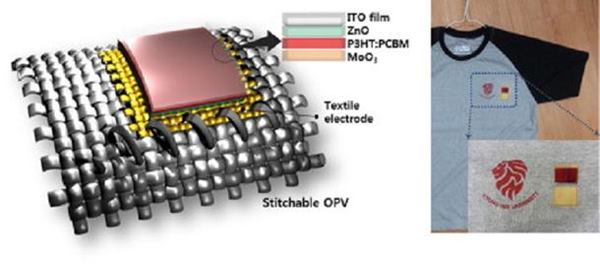Incorporating photovoltaics (PVs) into soft surfaces, such as apparel and architectural fabric, has been stymied by the rigid and frail nature of solid, conventional PV cells and thin films. That could soon change. Researchers at Kyung Hee University in Seoul, in partnership with Samsung, have developed a textile-based solar cell that uses organic photovoltaics (OPVs), which are lightweight, flexible, and inexpensive relative to inorganic PVs.
The conventional PVs must be adhered to fabrics, but OPVs can be woven directly into textiles due to their material composition. Rather than silicon, an OPV’s base electrode is made from fibers of nickel, copper, and gold-coated PET plastic. It is then covered in layers of indium tin oxide and zinc oxide, and topped with a polymer solar cell and transport layer.
In a paper to be published in the October 2014 issue of Nano Energy, the researchers claim that the new material is resilient and capable of repeated flexing and bending without damage. It can be stitched into a variety of clothing, bags, and other fabric accessories. And, if properly scaled, the OPV technology could be incorporated into tensile fabric architecture, providing canopies, tents, and other textile-based structures with the capacity to produce solar power.
OPVs have their limits, however. The researchers’ device demonstrated a conversion efficiency of 1.79 percent, much less than the conversion rate of 20 percent and higher for the most efficient PVs. Given its relative novelty, the material’s long-term stability is also not as well understood as that of established inorganic PVs, which have never meshed well with textiles—imagine tent structures with bold, adhered black PV strips that lack the lightness, suppleness, and visual compatibility of OPVs. The resulting awkward, layered constructions suggest a promising future for this research.
Blaine Brownell, AIA, is a regularly featured columnist whose stories appear on this website each week. His views and conclusions are not necessarily those of ARCHITECT magazine nor of the American Institute of Architects.
